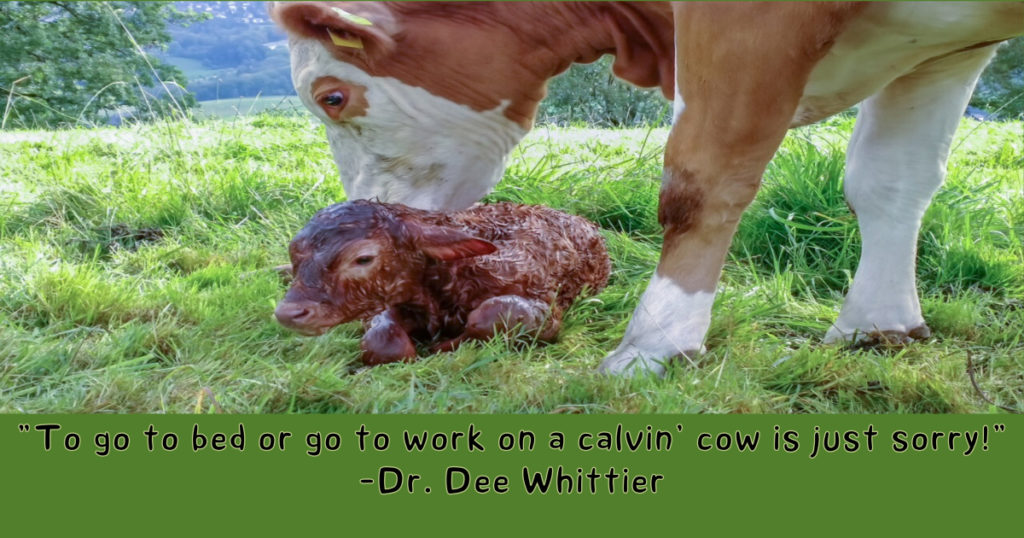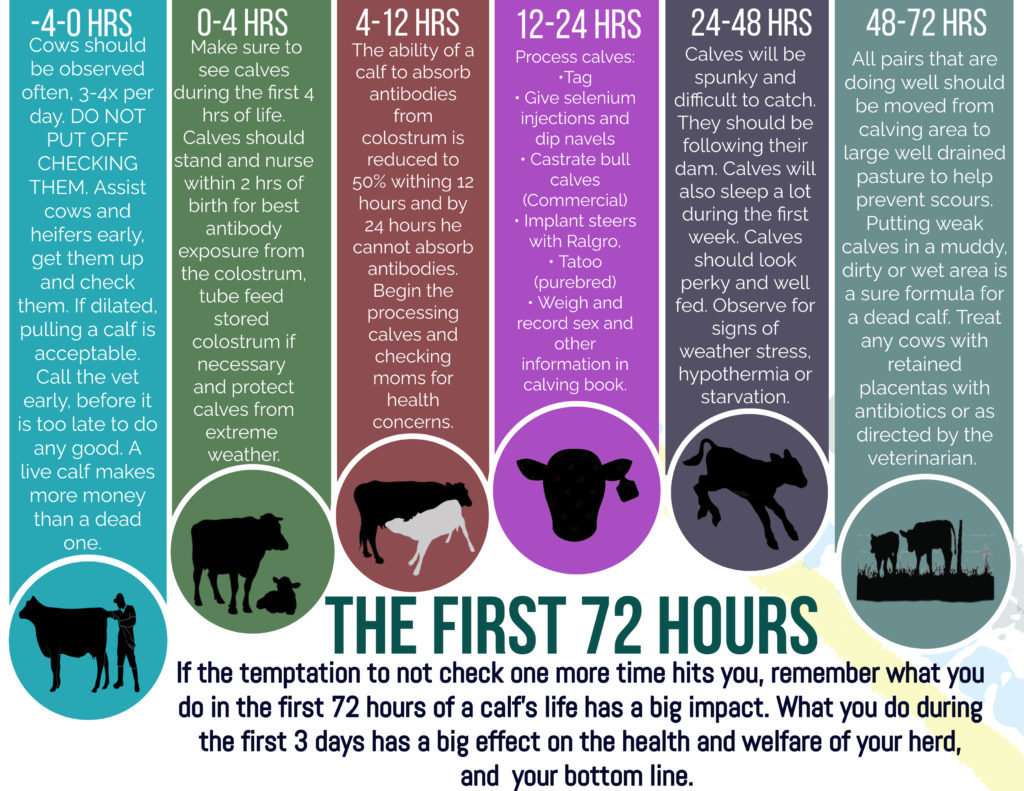Cow-Calf Critical Care for Calves First 72 Hours
It is that time of year when most of you are starting or in the midst of calving. The mild weather is a good sign that many farmers are having a mostly trouble-free time. Many cattle farmers have more on their plate than cows giving birth. It is important however that we don’t get caught up in the rush of calving season and overlook some basic management procedures. Sticking to the basics in cow-calf care will affect the calf for the rest of his life.
Here is a simple 72 hour time-line to follow:
Hour – 4 to 0 – Labor through Calving
Researchers in Montana found that almost 50% of calves that die in the first 24 hours after birth and most stillbirths are the result of dystocia or calving problems. It is very important that cows are observed often, 3 to 4 times per day, if possible and heifers even more often. “Whoa” you say, ” I can’t do that as a part-time beef producer!” You can if you use some tricks. Put heifers in a pasture near the house where they can be seen from a convenient window, this way you don’t have to truck out there every time. If cows are in a pasture that can easily be seen from the road, then you can check them to and from your off-farm job. Don’t forget to enlist the help of spouse, children and neighbors to give you a call if they see a cow or heifer calving.
Assist cows and heifers early. If you think there is a problem, get them up and check them. As long as the cow is properly dilated, pulling the calf a little early won’t hurt. In fact, research indicates that cows that are assisted early rather than allowed to struggle have healthier calves and breed back sooner.
Don’t be afraid to call the vet to review calving assistance procedures. If you nee help it is important to call before it is too late to do any good. Mitchell Veterinary Clinic will do everything possible for you to have Dr. Bryan available for you. Yes, a vet call will cost you, but a live calf makes more money than a dead one.

Hours 0 to 4 – Birth to Standing
Sometimes we do not see calves between just being born and up to 4 hours later, but hopefully we will see most of the calves during this very critical time. If weather is very wet or cold, we need to make sure we see calves during the first 4 hours of life.
Calves should stand and nurse within 2 hours of birth. If everything is normal and weather is not severe, a calf should be standing and moving around.
Calves need to nurse within four hours of birth. For maximum antibody exposure from the colostrum, a calf needs as much colostrum as possible. Cows in at least their third lactation generally provide higher-quality colostrum than heifers. A yellow color and a thick, creamy consistency are good indications of quality. Colostrum can be stored by freezing in milk cartons or plastic containers. Cows should be checked to see if they have been nursed or calves should be assisted in nursing.
Calves that experience a difficult birth take longer to stand and are more likely to succumb to weather stress. Weak calves need to be tube fed stored colostrum if they have not nursed by 4 hours. Remember colostrum is best in this order: Mom’s, stored beef cattle, stored dairy cattle then dried colostrum as a last resort. Antibody levels are highest in beef colostrum.
During extremely cold or wet weather calves should be moved to shelter or a calf warmer during this period if needed. Calves that are constantly shivering and have not nursed need to be warmed. Worse yet calves that are lethargic and unable to stand need help right away.
Signs of hypothermia in a calf are easy to spot. Erratic behavior, confusion and clumsiness are all signs of so-called “dummy calves” and mild hypothermia. If you put your fingers in the calf’s mouth and it feels cold, and the calf has no sucking reflex, it needs to be dried and warmed immediately.
Hours 4 to 12 – Standing to Processing
This is the last chance for the calf to get large amounts of colostrum for antibody transfer. By 12 hours, the ability of a calf to absorb antibodies from colostrum is reduced by 50% by 24 hours he cannot absorb antibodies. Calves that don’t get enough colostrum in the first 12 hours are more likely to have scours and respiratory problems.
Processing calves should begin at this time. All calves should be tagged. For commercial operations, a tag that has the same number as his mother is a good way to match cows and calves. If replacement heifers are kept, the tag can be changed later. Other procedures:
- Give selenium injections and dip navels
- Castrate bull calves (Commercial)
- Implant steers with Ralgro,
- Tatoo (purebred)
- Weigh and record sex and other information in calving book
If weather is severe, calves should be checked for hypothermia. Cow should be checked to see if they have “cleaned” or expelled the afterbirth.
Hours 12 to 24 – First day
Continue processing your herd. Calves are still susceptible to hypothermia, so make sure you check them regularly in severe weather. Make sure the cow is doing a good job of mothering the calf and the calf appears to be getting enough to eat. Calves that are lethargic, standing humped up or that look cold may not be getting enough to eat. Cows with mothering problems and their calves may need to be isolated in a barn or pen during the first day.
Hours 24 to 48 – Second day
Calves should easily be able to follow dam, but calves will also sleep a lot during the first week of life. Calves should look perky and well fed. Observe for signs of weather stress, hypothermia or starvation.
Cows (often first-calf heifers) that don’t mother their calves very well often have calves that do poorly or starve to death early in life. A quick check of his mom’s udder (either tight and overfull or flat and milk-less) will often reveal the reason this calf looks hungry. He is! That cow and calf need to be put in a pen or barn and observed to see if the calf is nursing and if the cow accepting the calf.
A calf that isn’t allowed to feed will dehydrate quickly.
Dehydration check:
1. Consider the calf’s vigor and overall attitude. A dehydrated calf won’t stand quickly, and it will show a reduced interest in nursing.
2. Assess the calf’s suckle reflex. Do this by placing a finger in the calf’s mouth to see how it responds. In well-hydrated calves, the reflex is strong; in dehydrated calves, it becomes weak.
3. Look at the calf’s eyes. As a calf becomes dehydrated, the eyeballs pull inward and there is a gap between the eyelid surfaces and the eyeballs.
4. Check the skin tend on the calf by pulling up the skin and releasing it. The more dehydrated, the longer it will take the skin to snap back into place. In a severely dehydrated calf, it can take 10 seconds or more to return to place.
5. Examine the calf’s gums and the mucous membranes. In a hydrated calf, they are moist, but they become sticky when dehydration sets in. When you press on the membrane of a well-hydrated calf, it will return to its original color quickly. A dehydrated calf will be slow to return to its normal color. This is called “capillary refill time,” but it doesn’t work on calves with black-pigmented gums.
Contact Mitchell Veterinary Clinic for advice on how best to treat dehydration and the amounts of fluid to use. Usually if the calf will stand and suck, oral fluids (good-quality electrolytes) will probably be enough to help the calf rehydrate. In more extreme cases of dehydration, an IV may be needed.
Hours 48 to 72 – Third day
Calves should be spunky and be hard to catch. All pairs that are doing well should be moved from calving area to large pasture. Keeping cow/calf pairs spread out on a large, well-drained pasture is a key to reducing the incidence of scours in young calves and therefore helping to prevent dehydration. Treat any cows with retained placentas with long acting antibiotic or as directed by your veterinarian before turning out to the big pasture.
Weak calves or cow/calf pairs with mothering problems should be moved from the calving pasture to a barn or special well-drained paddock for extra attention and care. Putting weak calves in a muddy, dirty or wet area is a sure formula for a dead calf.
If while you are out there fighting the cold or the rain and the temptation to not check one more time hits you, remember, what you do in the first 72 hours of a calf’s life has a big impact. What you do during the first 3 days has a big effect on the health and welfare of your herd as well as your bottom line.
Mitchell Veterinary Clinic looks forward to helping you be successful this calving season.

